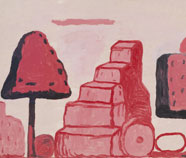Neo-Expressionism

Neo-Expressionism was a postmodern art movement that began in Germany in the early 1980s in reaction to the philosophies of modern art. This movement, which spread to other parts of Europe and the US, revitalized painting as a means of artistic expression. Like some other postmodern art movements, neo-expressionism did not shy away from human emotion and drew its inspiration from diverse aspects of culture. Many neo-expressionist artists benefited from the prosperous art market of the 1980s.
Neo-Expressionist paintings themselves, though diverse in appearance, presented certain common traits. Among these were: a rejection of traditional standards of composition and design; an ambivalent and often brittle emotional tone that reflected contemporary urban life and values; a general lack of concern for pictorial idealization; the use of vivid but jarringly banal colour harmonies; and a simultaneously tense and playful presentation of objects in a primitivist manner that communicates a sense of inner disturbance, tension, alienation, and ambiguity (hence the term Neo-Expressionist to describe this approach). Among the principal artists of the movement were the Americans Julian Schnabel and David Salle, the Italians Sandro Chia and Francesco Clemente, and the Germans Anselm Kiefer and Georg Baselitz. Neo-Expressionism was controversial both in the quality of its art products and in the highly commercialized aspects of its presentation to the art-buying public.




